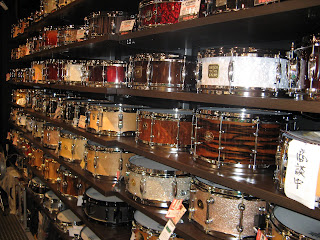

I am in Tokyo until Thursday (and then I take off for Kyoto): on Monday and Wednesday, I will be going to the Drum Music and the largest traditional Japanese drum and percussion shop in the country; so, I thought that I would just explore this afternoon [Sunday].
As I was wandering around, I stumbled around a four-story drum and percussion shop called Komaki Music: the Japanese Percussion Center. The story is divided among four floors: in the basement there is a room for drum clinics; above that, “Drum City,” which has an impressive selection of Western drum kits, snares, cymbals, sticks, and other accessories; on the next floor up, “Ethnic City,” which houses a diverse range of drums from all around the world; and on the top floor, “Percussion City,” which has a mix of traditional Japanese and Western orchestra percussion instruments.
While at Komaki Music, I began to understand something that I probably should have realized a long time ago: music is without boundaries. Sure, every culture produces a unique genre of music, and thus, unique instruments; nonetheless, because music knows no limits, it disregards all borders.
Music is something to be shared: the celebration of music can only truly begin with the unwavering dissemination of it. Furthermore, the labels and characterizations made by Western academia often are misleading and, more importantly, unnecessary. Such classifications constrict the true colors of music: this prospect goes against everything music represents – universality. Bluntly put, music is for everyone.
Without a doubt, I always have known that music is a universal enterprise; nonetheless, this concept was fully reinforced when I saw the diverse collection of drum and percussion instruments in Komaki Music.
For some unknown reason, I had anticipated that I would be exclusively researching taiko (traditional Japanese drumming): now, I realize that while in Japan, I may very well encounter “foreign” drums and schools of percussion. I am unsure why had rejected the prospect of foreign influence on Japanese drumming – especially, since the vast majority of my research in Fiji focused on the “foreign” (Indian) influence.
I write this diatribe because at Komaki Music, I purchased, “Percussion Magazine,” a Japanese music magazine that focuses on percussion instruments from all around the world. There are countless pictures of various Africa, Brazilian and Indian drums: some of these pictures even show Japanese musicians playing those “foreign” instruments. The embracement of these international instruments by Japanese musicians spawned my former revelation.







No comments:
Post a Comment